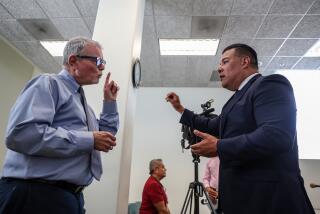Governor Tells Plan to Revamp Workers’ Comp
- Share via
SACRAMENTO — Hoping he has found the answer to a thorny problem, Gov. George Deukmejian announced Wednesday that he has reached agreement with officials representing business, labor and the insurance industry on a plan to thoroughly overhaul the state’s troubled $8-billion workers’ compensation system.
Under the proposal, which will require approval of the Legislature, maximum weekly benefits paid to hundreds of thousands of injured workers would more than double over the next three years, from the present $224 a week to $511 a week.
As a trade-off for the increased worker benefits, the plan proposes an end to such practices as “doctor shopping,” in which injured workers are able to choose their own physicians for diagnosis, and make it harder to collect for most psychological stress injuries, such as job burnout.
Under the proposal, workers would have to select their doctors from a panel of physicians pre-approved by the state. Stress injuries would be flatly rejected unless the injuries met “objective medical standards” or the worker could show some physical disorder con nected to the psychological injury.
As part of the deal, insurance companies agreed to give up an estimated $400 million a year in income over a three-year period by reducing rates charged to employers.
The proposal also calls for creation of a major new state bureaucratic agency, to be called the Division of Workers’ Compensation, that would have major responsibilities now split among the Department of Insurance and the Workers’ Compensation Appeals Board.
Flanked by influential business and labor leaders as he made the announcement, Deukmejian called the current workers’ compensation system “badly in need of reform” because the cost of running it is high while pay-outs to injured workers are among the lowest in the nation.
The Republican governor said the proposal “for the first time in years” would provide a substantial increase in benefits while putting in place what he described as “substantial reforms” for businesses that finance the system.
Deukmejian said he expects soon to find one or more legislative sponsors for the proposal and said he hopes the Legislature “will act as quickly as possible” on the measure.
The proposal, however, immediately ran into strong opposition from leaders of the highly influential and politically well-connected California Applicants’ Attorneys Assn., which was not among the groups that forged the agreement. The state’s roughly 750 applicants attorneys specialize in workers’ compensation cases.
Merle Rabine, president of the the association, criticized the proposal for ignoring a recent report on the workers’ compensation system, which found that insurance company profits are rising faster than claims made by injured workers. He said the proposal basically ignores insurance industry profits while zeroing in on doctors and lawyers involved in protecting workers.
“This proposal is clearly an employer/insurance company protection scheme,” Rabine said.
Donald C. Green, another applicant attorney, said the proposal would make “it more difficult for injured workers to get their benefits.” He also said the proposal would make the top weekly benefit available only to workers who earn at least $15 an hour by 1992.
Senate President Pro Tem David A. Roberti (D-Los Angeles), who was briefed on the proposal Tuesday, reacted cooly and noncommittally. “We find it a very interesting product. It obviously reflects a lot of positive work by the task force,” Roberti said in a statement released by his office.
The workers’ compensation system--entirely financed by employer contributions--was created to compensate injured workers while they are off the job and provide rehabilitation for those who cannot return to their old jobs but can be retrained for new ones.
More than 13 million California workers are covered by workers’ compensation. About 10% suffer some kind of job-related injury each year, but only about 400,000 of those injured workers will actually lose one day or more of work. About half that number, roughly 200,000 workers, will file claims for benefits, according to state officials.
Critics have long argued that the system is seriously flawed because workers receive such low benefits relative to the amount that employers pay into the system, about $8 billion a year. California’s maximum weekly benefit has been frozen at $224 since 1982 and ranks 45th among states. Despite that, costs to employers have been soaring, up 85% since 1983.
While there is wide agreement that something is wrong, there has never been a consensus on the cause for the rise in costs and the remedy. Some critics say that doctors and lawyers make too much money from the system, while others say insurance companies are reaping excess profits. Insurance companies, business groups, labor unions and attorneys have periodically formed alliances, then split apart, with none of the major players willing to make concessions.
Deukmejian brought labor, business and insurance industry officials together last year when efforts to reach a legislative compromise on a workers’ compensation reform bill once again failed.
At his Capitol press conference Wednesday, the governor was flanked by John Henning, leader of the California Labor Federation, who has been one of the governor’s most vocal critics over the years, as well as a group of business and government representatives who formed the alliance.
They included Ed Mangiafico, chairman of the May Co. and president of Californians for Compensation Reform, a coalition of employers, government agencies and insurance companies; Kirk West, president of the California Chamber of Commerce; Larry Naake, president of the County Supervisors’ Assn., and Robert Pucinelli, chairman of Industrial Indemnity, an insurance firm.
Henning said “many months of negotiations” were required for the agreement.
The labor chief singled out the injured worker benefit increases that after three years will guarantee workers who qualify for the maximum payment 100% of the state’s average weekly wage. The benefit will increase automatically after that without requiring legislative action, as is now the case. Workers will have to be earning about $15 an hour in 1992 to qualify for the maximum benefit, so many workers will presumably receive a lesser payment.
Despite that, Henning said, “This is a historic victory from our point of view. We no longer have to come (to the Legislature) as political beggars time and time again.”
Costs to employers would go up about $1 billion over three years. But business leaders said the various reforms in the proposal will mean that the increases in the future will not be nearly as dramatic as they have been.
More to Read
Get the L.A. Times Politics newsletter
Deeply reported insights into legislation, politics and policy from Sacramento, Washington and beyond. In your inbox twice per week.
You may occasionally receive promotional content from the Los Angeles Times.










